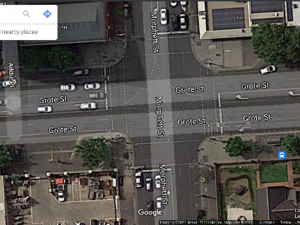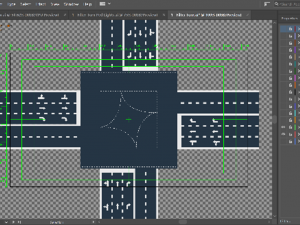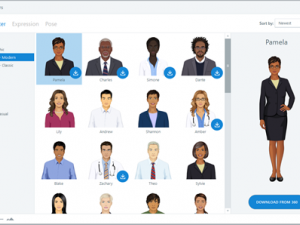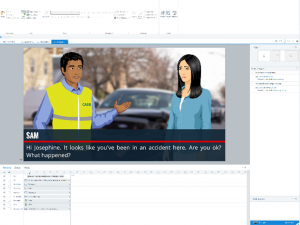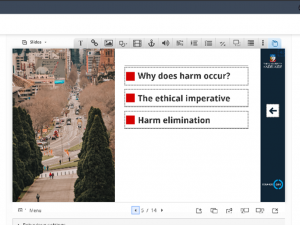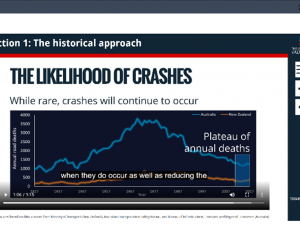Safe System for Road Managers and Engineers: our course development journey
In our Learning Designer and Course Builder roles within Learning Enhancement and Innovation (LEI) we recently approached the challenge of designing and developing an online short course (OSC) for road engineers and managers. This course aims to increase their ability to determine what road design is and is not well- aligned with the Safe System philosophy. This philosophy for road safety has an objective of harm elimination and road engineers and managers have a responsibility to identify practical ways to implement this system. We designed and developed this course in collaboration with subject matter experts (SMEs) from The Centre for Automotive Safety Research (CASR).
Course design
In discussion with the subject matter experts (SMEs) from CASR it was decided that the learning materials should include case studies incorporating traffic collision scenarios and narrated presentations (content snippets) of core content. The case studies and content snippets were designed and developed to be highly innovative learning resources, placing the learner in real life scenarios and supporting them to determine the most appropriate solutions to real problems on our roads. They also demonstrate what can be achieved when SMEs, Learning Designers and Course Builders pool their expertise.
We approached the development of this course from the design perspective that all resources should be embedded in learning sequences which are clearly described in terms of topic overviews, learning activities and learning objectives. Each of the six topics is summarised in a short introductory paragraph. Following that the students are provided with explicit information about the learning activities and what they should be able to do as a result of completing the learning activities. Learners have the opportunity to test their knowledge and skills at the end of each topic by completing a short quiz with immediate feedback provided.
Read further to find out more about the design and development of this course in collaboration with CASR.
Case Studies
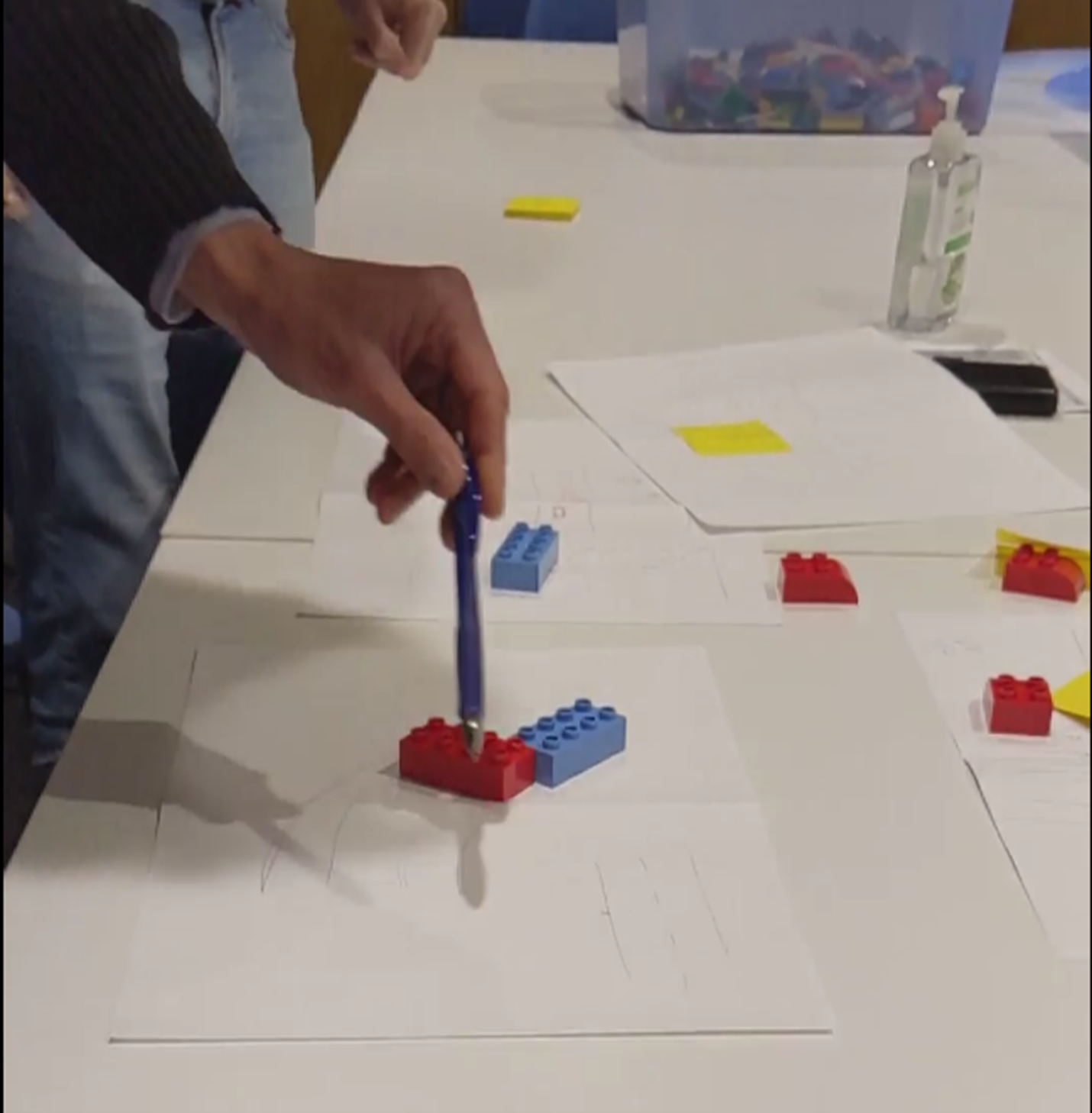
Simulating traffic collision scenarios using Lego blocks
Throughout the development of resources for this course, our focus remained on each resource being part of an organised learning sequence. Traffic collision scenarios were developed to be included within interactive case study branching scenarios. Each of these case studies has an organised structure in which the scenario is presented as an animated story incorporating the traffic collision scenario and the options for improving the situation as an engineer are listed. The learner is then prompted to take on the role of an engineer to explore each solution. Images and diagrams are included together with narrated text providing feedback about each solution. The benefits of each solution, together with any potential issues and a summary are provided. There are no correct or incorrect solutions and the learner is encouraged to explore all options.
The traffic collision scenarios resulted from an initial brainstorming session in which the SMEs suggested that learners would better understand the traffic collision scenarios if they were recreated in animations. Nine scenarios were recreated through simulations using Lego blocks. The different road layouts were drawn on paper, while Lego blocks served as representations of vehicles or pedestrians. We recorded these simulations so that they could be our animation references.
To maintain the accuracy of road layouts and markings, we asked the SMEs to identify places in and around Adelaide where these road types would be typically found. We then found these places in Google Maps using the Satellite view, and recreated them using Adobe Illustrator.
After the road layouts and other visual assets such as vehicles, pedestrians, traffic signs and vegetation were organised in individual layers in Adobe Illustrator, they were imported to Adobe After Effects where the bulk of the animation work took place. The following elements were considered to ensure that we would be able to depict the traffic collision scenarios:
- Road measurements were taken using Google Maps so that we could calculate the correct speed for animating the assets
- Assets such as vehicles and pedestrians were animated using custom paths
- Speed graphs were used to enhance the animation of impacts and other abrupt events
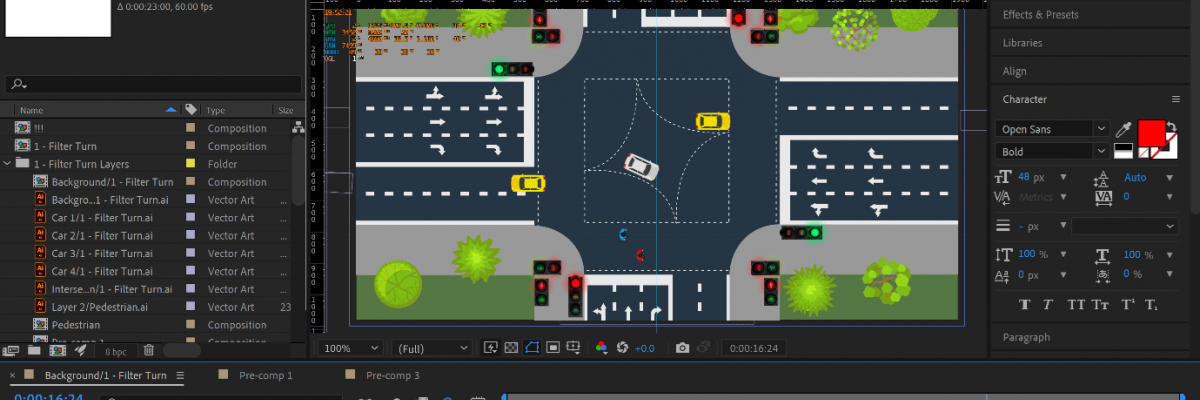
Importing multi-layered Adobe Illustration files in Adobe After Effects made it easier to animate individual elements
In addition to investigating the technical aspects of traffic collision scenarios, there was also a need to convey the emotional aspect of these incidents to victims and other parties involved. Sound learning design principles based on cognitive psychological research as cited by Nilson and Goodson (2018) suggest that learners are more engaged when stories evoke emotions and that human faces, colour, movement and drama also enhance learning. To address this, the SMEs prepared scripts of conversations between a fictional crash investigator and victims. Filming actors acting out these conversations would be ideal, but laborious and costly. We then relied on Articulate Storyline, another widely-used e-learning authoring tool for creating animations of these conversations. Storyline has the following advantages:
- Built-in library of diverse characters. The characters’ facial expressions and pose can be manipulated to make the animations more life-like
- Text-to-speech function for voice-overs
- Built-in library of male and female voices of different geographical accents
After the animations were developed, actual dash camera footage and the previously developed traffic collision scenarios were stitched in. The final product was then published as a video resource.
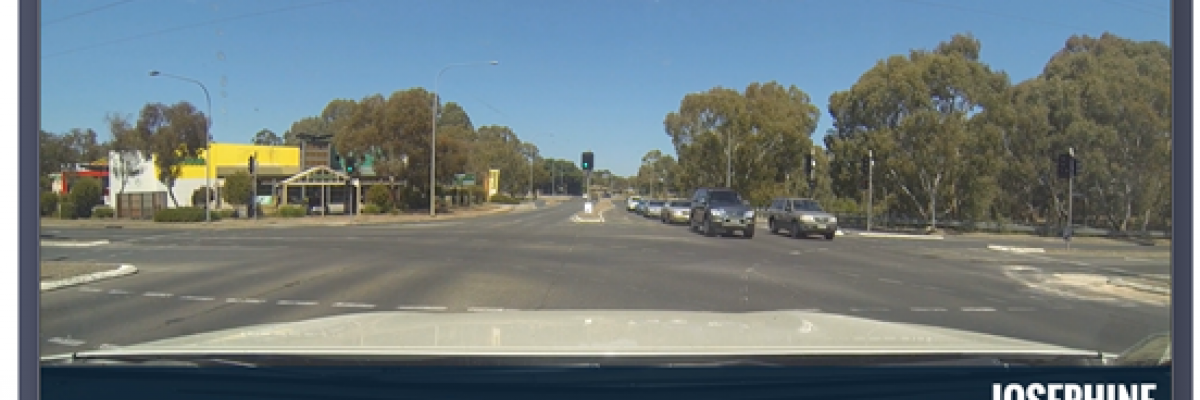
Stitching in actual dash camera footage and the traffic collision scenario animations were easy and straightforward in Articulate Storyline
Based on sound learning design principles (Nilson and Goodson, 2018), these case study branching scenarios have been designed to actively engage learners by questioning them and having them make decisions rather than passively watching or listening.
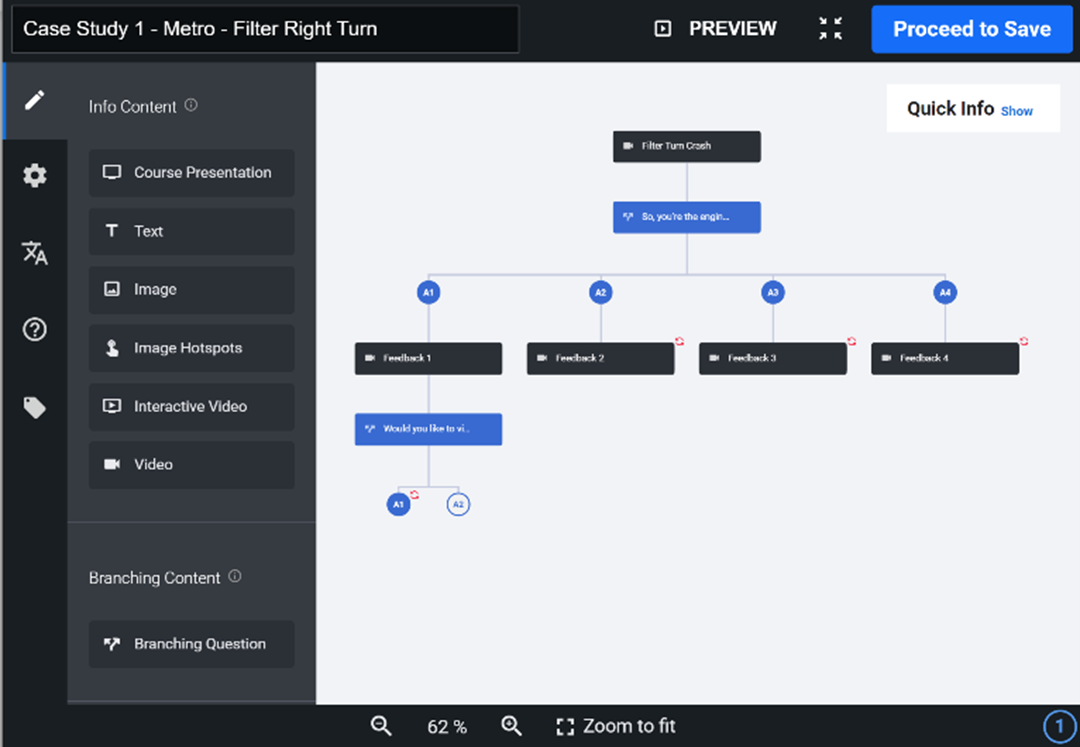
H5P Branching Scenario’s user interface. Each block above is a screen that the learner may visit.
It was decided that the learners should be able to explore different solutions to the crash incidents experienced by the victims. To facilitate this, we used H5P Branching Scenario. This allows learners to freely explore different solutions once they have watched the conversations. Learning design principles (Nilson and Goodson, 2018) also recommend that learners should receive immediate feedback where possible. These branching scenarios are designed to provide immediate feedback as learners explore the possible engineering solutions.
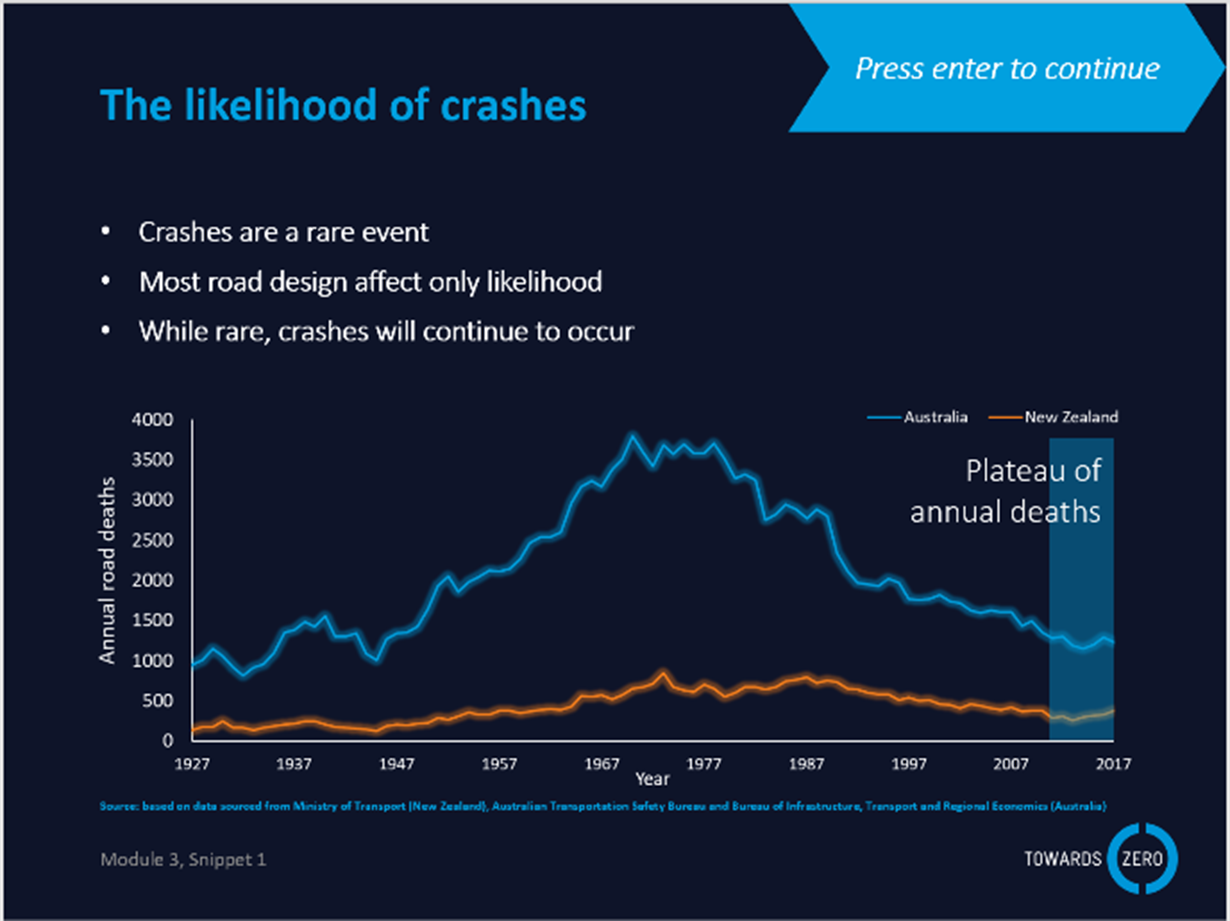
Screenshot of a typical slide in a snippet. These were accompanied by voice-overs.
Content snippets
The SMEs wanted to include decks of PowerPoint slides in the course. These contained the bulk of the content. They called these deck of slides ‘snippets’. These ‘snippets’ had embedded voice-overs in each slide which helped explain the concepts. They could have simply been uploaded to the course for learners to download, but this solution may have been problematic. For example, these ‘snippets’ may not have been fully accessible to learners using mobile devices.
Instead, we converted these slides to H5P Course Presenters, a widely-used e-learning authoring tool which offers the following advantages:
- They could be embedded in course pages without requiring the learners to download anything.
- Captions can be inserted alongside voice-overs, which improves accessibility.
- Ease of use for developers.
We first recreated the slides in Adobe After Effects. This contained the images, text and voice-overs within the videos. We then uploaded these to Studio, which has an automatic caption- generating feature. This feature has a claimed ~85% accuracy, hence some manual checking and clean-up were needed.
Finally, the videos and captions were organised using H5P Course Presenter using a template that has been developed for OSCs.
The use of animated images and diagrams supported by a narration with an option to view captions and/or download a transcript provides an accessible and engaging experience for learners. Usability is enhanced by the use of H5P Course Presenter (rather than PowerPoint) which allows them to be embedded in course pages. To create a meaningful learning sequence incorporating these content snippets, each one is preceded by a list of questions for the learner to consider while watching and listening. This is a sound learning design principle which supports the learner to watch and listen with purpose.
Summary
This OSC uses a wide range of technologies to provide engaging learning based on sound learning design principles. The course is self-contained and self-paced and can be completed in 6-7 hours online. There is an online assessment (quiz) at the end of the course. A certificate of achievement is generated when a score of 70% or more is achieved. This course is available for enrolment now by selecting the link below:
Online Short Course: Safe Systems for Road Managers and Engineers
Reference: Nilson, LB & Goodson, LA 2018, Online teaching at its best : merging instructional design with teaching and learning research, 1st edition, Jossey-Bass, San Francisco, California
Cecily Wright, Learning Designer, & Mark Carandang, Course Builder, PACE Project Team, LEI

